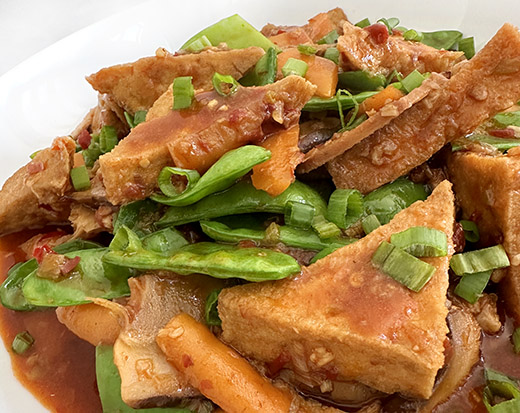Years ago, when I first became obsessed with cooking, my fascination was with successful results. When I could reproduce what was represented in a recipe without catastrophe, it was thrilling. All these years and many cookbooks later, I’m still delighted by successes with recipes that are new to me. But, I’m now also fascinated by learning new techniques that are better than what I’d been doing previously. I recently had just that kind of experience with a dish from The Vegan Chinese Kitchen by Hannah Che of which I received a review copy. This book showcases the author’s interest in connecting her culture with her desire to follow a plant-based diet. She began to discover vegetarian and vegan traditions in Chinese cooking and then attended the only vegetarian cooking school in China, in Guangzhou. She also spent a year learning about Buddhist vegetarian cooking in Taiwan. She writes: “Becoming vegan didn’t alienate me from my heritage, as I’d feared, but actually motivated me to understand it even more.” Luckily for all of us, her journey has brought about a book full of vibrant, meatless, Chinese recipes. The chapters represent ingredient categories, and right away, I was pulled in by Leafy Greens which is the first. The Blanched Spinach with Sesame Sauce calls for sesame paste, and the book includes a recipe for a homemade version. It was as delicious as the photo in the book looked. A few pages later in the same chapter, I tried the Napa Cabbage and Vermicelli Salad and incorporated some local vegetables that were available at the time. As mentioned in the recipe head note, it was indeed great as leftovers for lunch. From the Stems, Shoots and Flowers chapter, I was inspired to make homemade bean sprouts. And, there’s a Stir-Fried Bean Sprouts with Chinese Chives recipe I have marked. I’m also eager to try the Fish-Fragrant Eggplant so named because fish were often cooked the same way with chiles, ginger, and garlic. There’s a lot to explore in the Tofu chapter as well as in the Tofu Skin chapter. There are mock meats like the Vegetarian Roast Goose made with shitakes and bamboo shoots and no actual goose. The chapter for Gluten, or seitan, includes recipes for making your own plus poached gluten rolls, fried gluten puffs, and raised gluten. You’ll also find mushroom recipes, noodle recipes, dumplings, and a version of Scallion Pancakes that’s a must-try. The dish that taught me an excellent technique, though, was the Homestyle Braised Tofu.
This recipe involves frying tofu, and let me start by explaining my previous process for frying tofu. In the past, I would press blocks of tofu between plates, weighted down with whatever was handy, to remove water. Then, I would cut the tofu into pieces and pat them dry before tossing them with cornstarch. Without fail, when I slid the coated tofu pieces into hot oil it would spatter wildly making a huge mess all over the top of the stove, the backsplash, the floor in front of the stove, and me and whatever I was wearing. Here, you are instructed to skip pressing the tofu, and just cut it into pieces to be added to boiling, well-salted water. The tofu was left to soak for a few minutes and then removed with a slotted spoon and drained on a towel-lined sheet pan. After draining, the tofu was then fried in a wok. On the Tofu FAQ page, Che explains that no one in China presses tofu. Instead, by soaking it in salted water, cold water inside the tofu is drawn out and the tofu is seasoned. It firms up a bit and fries with much less mess. And, it worked beautifully! No spattering at all. I’m now a convert to this way of frying tofu. For the rest of the recipe, dried shitakes were rehydrated in boiling water, drained, and halved. The mushrooms were stir-fried with garlic, ginger, and green onion before chile bean paste was added followed by soy sauce and water. The fried tofu was added with sliced carrot and cooked for a few minutes before adding snow peas. I was actually able to get local snow peas at Boggy Creek Farm on the day I had planned to make this which was perfect. It was topped with chopped green onion tops before serving.
The chile bean paste made the dish spicy and full-flavored, and the texture of the fried tofu was just right with crispy edges and chewy centers. For the first time, frying tofu wasn’t a dreadfully messy cooking adventure. I’m definitely willing and able to learn new tricks in the kitchen, and there’s a lot more to learn and taste from this book.
I am a member of the Amazon Affiliate Program.








Looks very inviting...if only I ate tofu!
ReplyDeleteThanks for the tip on frying tofu. I find tofu to be rather bland tasting on its own, but frying it along with some bean paste sounds like a tasty idea!
ReplyDeleteWhat a gorgeous way to serve tofu! I bet it tastes terrific, too!
ReplyDelete